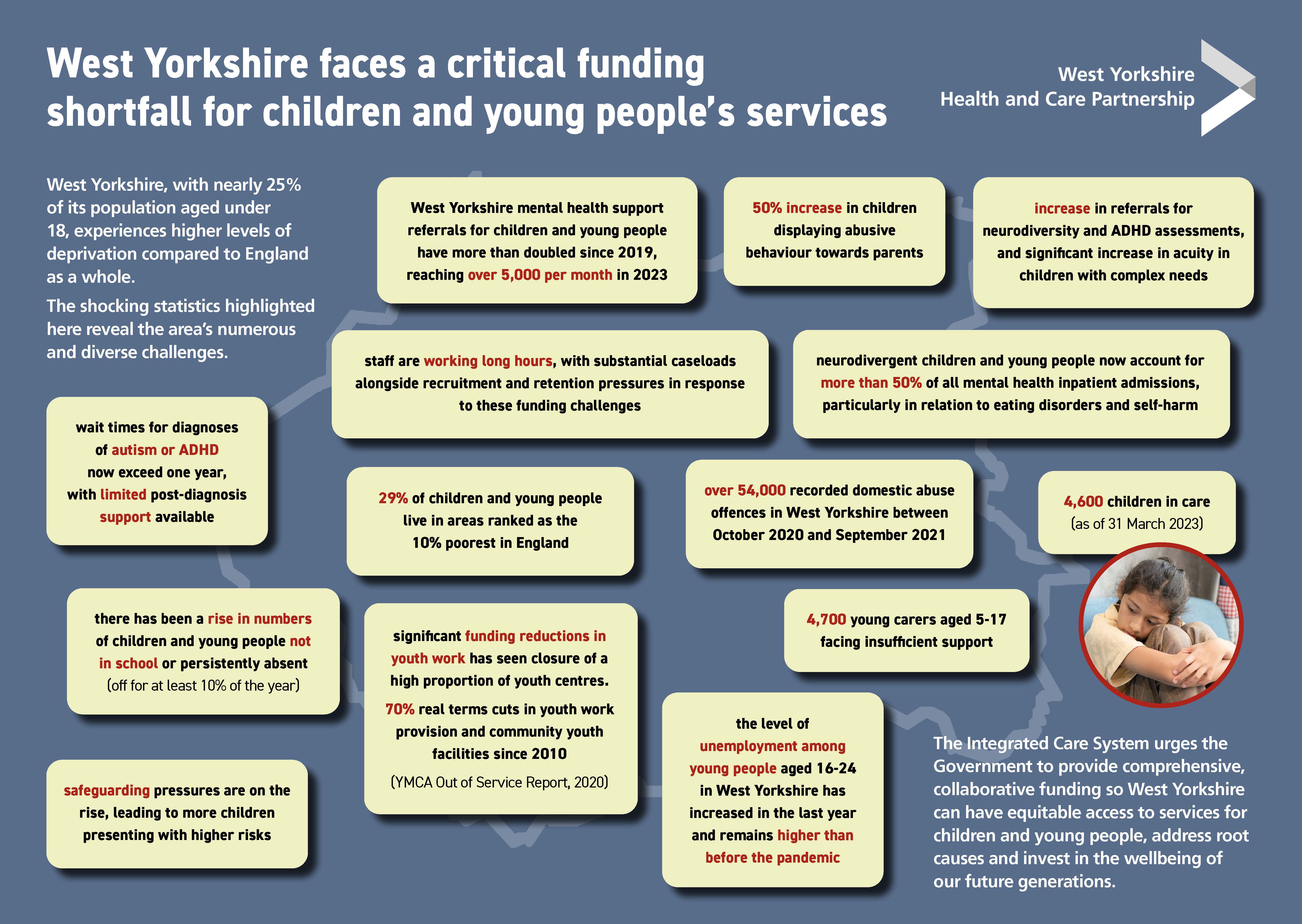Posted on: 18 January 2024
Children and young people’s services in West Yorkshire are under threat due to the provisional local government finance settlement for 2024/25. The unsustainable financial strain on local councils has created a crisis that jeopardises the positive standing of local councils, including those currently rated by Ofsted as 'outstanding’, and risks hindering progress in other areas.
The sector faces four severe challenges:
- A long-term squeeze on children’s services funding that has seen resources increasingly focused on acute services and has come at the expense of universal and preventative services.
- A lack of capacity in children’s social care placements [and the rising cost of private provision] that is driving astronomical care costs and year on year overspends within children’s services.
- A national workforce crisis that is affecting the quality and availability of care for children and families.
- Rapidly growing demand, which has been compounded by child poverty and the cost-of-living crisis. The number of children in care and the complexity of cases has increased.
The area's health and local government leaders across the West Yorkshire Integrated Care System have come together to issue an urgent call for funding to allow councils to deal with the crisis and reset the system, so that investment can be refocused on earlier support for children and families.
Key points
1. Financial strain and the urgent need to invest in early intervention
- Children's social care spending reached £11.1 billion in England in 2021/22, indicating 41% real terms increase since 2009 [ADCS, 2023]
- Increased spending on late intervention is forcing impossible budget-balancing decisions, crippling local councils
- For example, projected spend on adult and children's services in Bradford this year is equivalent to 87% of the agreed budget for 2023/24, leaving no room for other essential services
- Child poverty and the cost-of-living crisis are contributing to greater adversity, trauma and health inequalities in West Yorkshire. Children and young people are exposed to multiple risks that affect their well-being and development, increasing safeguarding pressures
- Rises in child poverty were associated with over 10,000 more children being taken into care in England between 2015 and 2020 [Bennett & Schlüter, 2022]. In West Yorkshire there are 4,600 children in care [as of 31 March 2023; Children looked after in England National statistics]
- West Yorkshire's good practices and evidence-based working are undermined by financial constraints
- It is over 18 months since the Independent Review of Children’s Social Care recommended a radical reset of the system, with more funding for prevention and family support, to transform the lives of children and families
- West Yorkshire public health teams are committed to allocating the Public Health Grant to essential children's services, including health visiting, school nursing, and support for healthy pregnancies. However, a recent report by the Health Foundation highlights a worrisome 26% real-terms reduction in the grant's value over the past decade, posing significant challenges and genuine concern for public health directors in West Yorkshire
- Leaders across the West Yorkshire Integrated Care System are actively participating in the Government's consultation process to address this critical issue
- Councils must be sufficiently resourced to deal with the crisis and reset the system, so that investment can be refocused on earlier support for children and families.
2. Lack of capacity in children’s social care placements
- The Local Government Association has found that the number of children’s social care placements costing £10,000 or more per week has risen by more than 1,000% in five years. They found that 98% of local authorities said that the lack of choice in placements and rising costs of private provision was driving the high prices
- Leaders across the West Yorkshire Integrated Care System support the Association of Directors of Children’s Services call for a comprehensive national placement strategy “to ensure the right placements are available in the right locations and at the right time”.
3. Workforce crisis in children's services
- Recruitment and retention of staff are major challenges, with more social workers moving to agency contracts, and residential workers leaving the sector entirely
- The sector faces the highest level of workforce turnover since 2013 and the first decline in overall numbers of children’s social workers in a decade
- Staff shortages create instability for children in care, as they reduce their chances to build relationships, which are important for their well-being and sense of security
- The Government must recognise and address the workforce crisis as a matter of urgency and provide adequate funding and support for the staff who care for the most vulnerable children in our society.
4. Increasing needs and referrals
- These challenges extend to 4,600 children in care in West Yorkshire
- 4,700 young carers in the region lack sufficient support [Census, 2021].
- Referrals for children and young people's mental health in West Yorkshire have more than doubled since 2019, reaching over 5,000 per month in 2023, exceeding the capacity of existing services.
- Waiting times for diagnoses of autism or ADHD are unprecedented. Most wait over a year, with insufficient funding available post-diagnosis. Those joining the waiting lists now, will wait longer
- An unprecedented number of applications for education health and care plans [EHCPs] are being made across West Yorkshire which is putting a huge strain on special educational needs and disability services within local authorities
- Funding is urgently needed to support the reduction of unacceptable waiting times for essential services and secure a fulfilling future for every child in West Yorkshire.
Further information
- West Yorkshire Position Statement: Children and Young People’s Services.
- Children and young people infographic.


